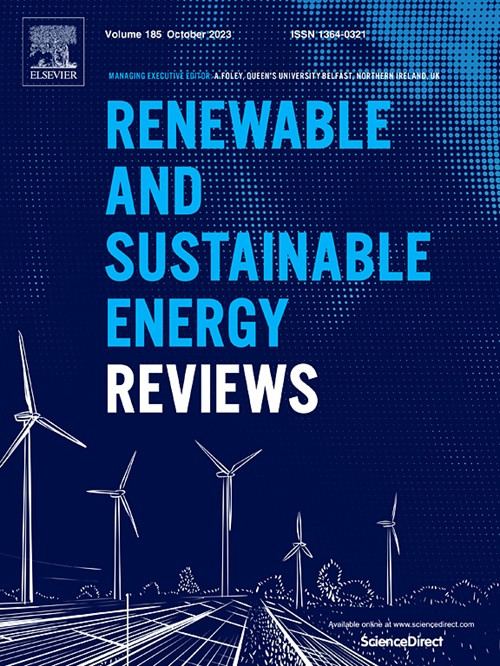Unpacking the role of green supply chain and renewable energy innovation in advancing environmental sustainability: A Quantile-Based approach
IF 16.3
1区 工程技术
Q1 ENERGY & FUELS
引用次数: 0
Abstract
Renewable energy innovations and the green supply chain are essential to sustainable development goal 9. Furthermore, these elements play a key role in facilitating eco-friendly energy generation, indirectly aiding the progress towards SDG 9. Transitioning from conventional to green energy sources is vital for long-term sustainability and promoting an environmentally conscious framework. Consequently, this study explores the primary drivers of environmental sustainability, measured through the load capacity factor (LCF), from 1990Q1 to 2022Q4. Additional factors such as energy prices, GDP, and financial development are also analyzed. To address the asymmetric distribution and non-linearity of the data, this study applies advanced quantile-based methods, including quantile-on-quantile regression (QQR), quantile-on-quantile Granger causality (QQGC), and wavelet quantile regression (WQR). The results indicate that green supply chain (GSC) practices, energy prices (ENP), renewable energy innovations (REI), and financial development (FinD) all positively contribute to enhancing environmental sustainability, as reflected in the increased LF. In contrast, GDP has a negative impact on environmental sustainability, reducing LF across all quantiles. The findings of QQGC demonstrate that all key variables, including GSC, REI, ENP, GDP, and FinD, are significant predictors of LCF at different quantiles. Based on these insights, the study proposes policy recommendations aligned with SDG 9 to improve environmental sustainability further.

揭示绿色供应链和可再生能源创新在促进环境可持续性中的作用:基于分位数的方法
可再生能源创新和绿色供应链对可持续发展目标9至关重要。此外,这些要素在促进生态友好型能源生产方面发挥着关键作用,间接有助于实现可持续发展目标9。从传统能源向绿色能源过渡对于长期可持续性和促进具有环境意识的框架至关重要。因此,本研究探讨了环境可持续性的主要驱动因素,通过负载能力因子(LCF)来衡量,从1990年第一季度到2022Q4。此外,还分析了能源价格、GDP和金融发展等其他因素。为了解决数据的不对称分布和非线性,本研究采用了先进的基于分位数的方法,包括分位数-分位数回归(QQR)、分位数-分位数格兰杰因果关系(QQGC)和小波分位数回归(WQR)。结果表明,绿色供应链(GSC)实践、能源价格(ENP)、可再生能源创新(REI)和金融发展(FinD)都对提高环境可持续性做出了积极贡献,这反映在LF的增加上。相比之下,GDP对环境可持续性有负面影响,降低了所有分位数的环境可持续性。结果表明,GSC、REI、ENP、GDP和FinD等关键变量在不同分位数上都是LCF的显著预测因子。基于这些见解,该研究提出了与可持续发展目标9相一致的政策建议,以进一步提高环境可持续性。
本文章由计算机程序翻译,如有差异,请以英文原文为准。
求助全文
约1分钟内获得全文
求助全文
来源期刊

Renewable and Sustainable Energy Reviews
工程技术-能源与燃料
CiteScore
31.20
自引率
5.70%
发文量
1055
审稿时长
62 days
期刊介绍:
The mission of Renewable and Sustainable Energy Reviews is to disseminate the most compelling and pertinent critical insights in renewable and sustainable energy, fostering collaboration among the research community, private sector, and policy and decision makers. The journal aims to exchange challenges, solutions, innovative concepts, and technologies, contributing to sustainable development, the transition to a low-carbon future, and the attainment of emissions targets outlined by the United Nations Framework Convention on Climate Change.
Renewable and Sustainable Energy Reviews publishes a diverse range of content, including review papers, original research, case studies, and analyses of new technologies, all featuring a substantial review component such as critique, comparison, or analysis. Introducing a distinctive paper type, Expert Insights, the journal presents commissioned mini-reviews authored by field leaders, addressing topics of significant interest. Case studies undergo consideration only if they showcase the work's applicability to other regions or contribute valuable insights to the broader field of renewable and sustainable energy. Notably, a bibliographic or literature review lacking critical analysis is deemed unsuitable for publication.
 求助内容:
求助内容: 应助结果提醒方式:
应助结果提醒方式:


